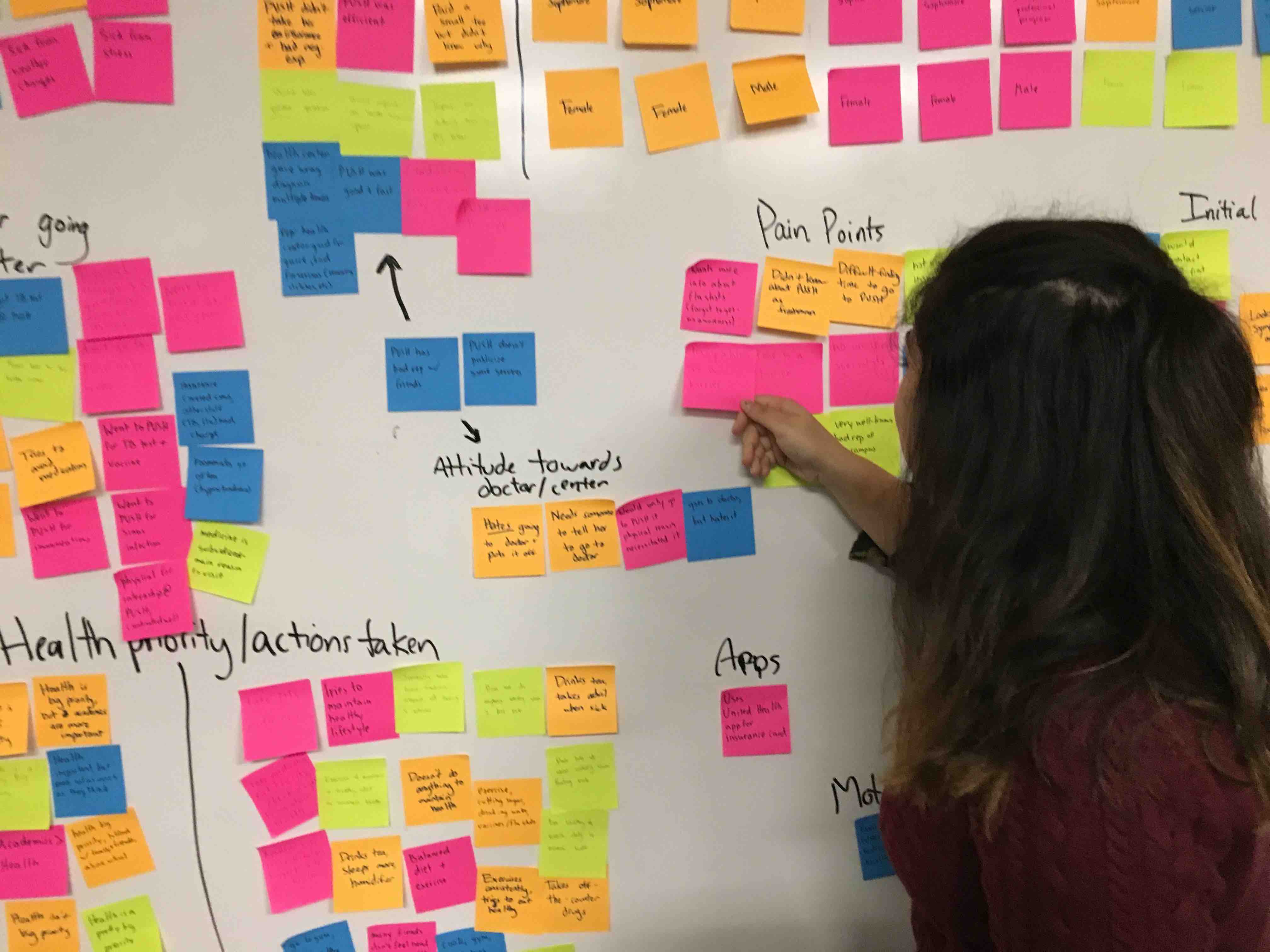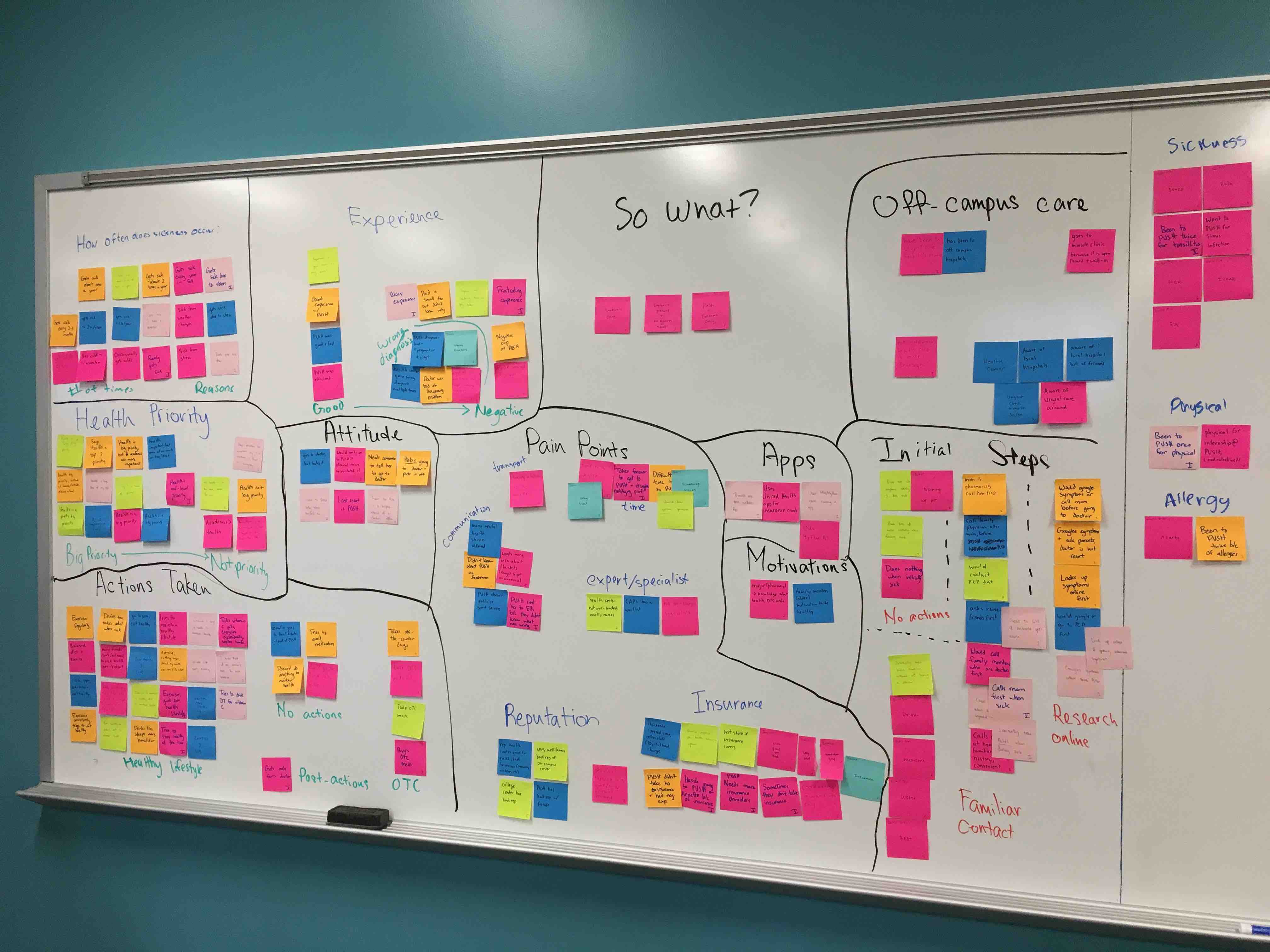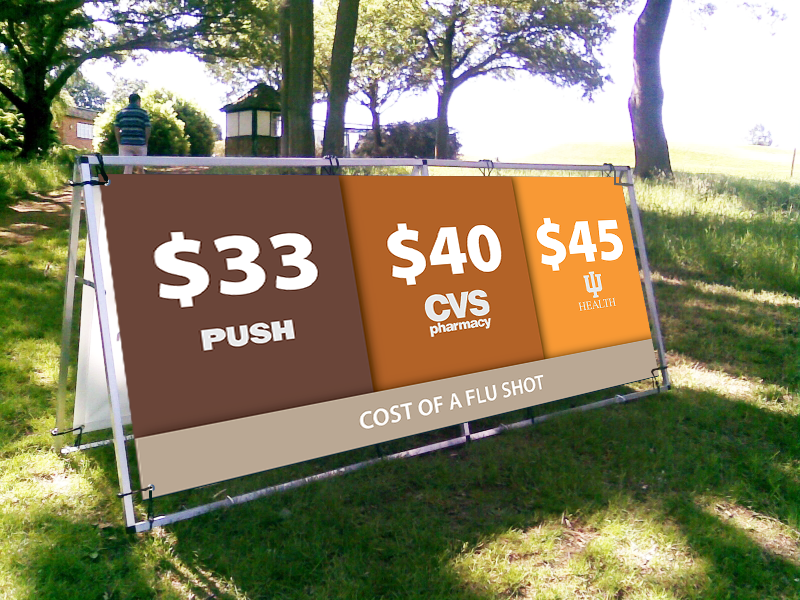Cerner Semester Project

Team
6 students
Project
1 semester UX semester project working with a corporate sponsor
My Role
Created and developed our timeline and milestones Led 2 expert interviews Conducted and analyzed 7 student interviews Worked collaboratively to create an affinity diagram, personas, and a journey map Responsible for secondary research on existing campaigns in final phase of project Created 3 logo options and conducted preference testing Built a branding kit
Intro
College students don’t access health care. Why is this?
As part of a semester-long class project, we worked with Cerner Corportation, a company that creates medical IT products. They are interested in developing for the college space, but lacked research about how college students interact with their health care systems. Our focus was on understanding how college students interact with their health care systems.
Research
To begin our research, we wanted to learn about student healthcare from the administrative perspective. I led two expert interviews with two people in the medical field.
Interview with Dr. Walenga
The first interview was with Dr. Gail Walenga, the director of our on-campus health care center, PUSH. We wanted to understand PUSH's perspective on addressing student health care needs. We asked questions regarding to gain a background about PUSH's services, learn the strengths and weaknesses of PUSH's current operations, and understand how different situations are handled.
Our most important takeways from the interview were:
- Communicating with students is limited and challenging
- PUSH offers many free or low cost services, including a pharmacy next door
- Lack of insurance can be a barrier for services such as lab work and radiology, but consultations are free regardless
- Students do not generally visit on a regular basis apart unless managing chronic conditions
Interview with Professor Murawski
In his opinion, having access to on-campus health care does not increase students' motivation to access healthcare because the tendency for the 18-25 age group is to believe that they are “invincible,” or in other words that they can easily overcome sickness without external help, thus as an age group they tend not to take advantage of health care services. Barriers such as lack of insurance also decrease students' motivation.
Survey
In order to reach a broad audience of students and understand their perspective, we conducted a survey. Our survey recieved over 160 responses, mostly from Purdue respondents. The distribution was about 58% male and 24% female, and 96% are in the 17-25 age group.
We learned that students self-describe as prioritizing their health and taking preventative action. PUSH is seen as a last resort, and many students will do anything such as drinking fluids, resting, and taking medicine before visiting PUSH or another health care facility.
Logistical issues with PUSH and a negative reputation combine to create more reasons students avoid on-campus health care.
Student Interviews
Along with the survey, we wanted to dig deeper into the qualitative experience of interacting with health care by doing interviews. We conducted interviews with students from both Purdue and similar sized colleges across the country. These quotes summarize students' general attitudes towards healthcare:
"If I’m sick, and I have homework to do, I’ll do the homework, despite being sick.""
"I don’t want to be that stupid person that goes to PUSH for something that’s completely common.""
"I’ve heard that they [PUSH] generally will tell you either one of two things: either you’re pregnant or dying...or give you some weird diagnosis.""
From our interviews, a few common themes stood out:
- Students claim they eat healthy and exercise regularly to prioritize their health
- Many students fall sick a few times a year, self-attributed to stress
- Negative experiences tended to be due to payment issues or incorrect diagnoses
- Lack of knowledge about services, lack of time, and the negative reputation of on-campus health care are all barriers
Analysis
Affinity Diagramming

In order to synthesize the different data sources, we created an affinity diagram of the key insights from each interview and broad survey themes. Our goal was to find patterns in the data and identify common pain points. The main pain points we found connected with what we had learned from experts: lack of communication between PUSH and students created a barrier. Additionally, PUSH's negative reputation prevents students from considering utilizing their services. Other barriers include time, lack of insurance, lack of on-campus specialists, transporation (for other medical services) Students lacks info about the services that health care centers provide.
Personas

Based off of the different themes, behaviors, and how much students claimed to prioritize their health, we created three personas to represent our users.
The first is Robert, who believes he leads a healthy lifestyle because he exercises, but eats a great deal of junk food. An in-state student, he relies on his primary care provider back home and frequent calls to his mom when he gets sick.
The second is Josephine, who makes an effort to take care of her health by eating healthy foods. As an out-of-state student, she must rely on the local health care.
Last, Katherine is new to her college and is unaware of what services the on-campus center offers, but she knows it has a bad reputation. She never learned how to prevent from getting sick, so she drinks tea frequently in hopes of boosting her immune system.
Journey Map

We also used the data we collected to construct a journey map detailing how each persona would handle getting sick. The map shows the individual's actions and mood as they go through the different steps in their journey. This reflects the broad themes we found through our analysis.

I used Adobe Illustrator to create a digital visualization of our collaborative in-class work.
Ideation
The research we conducted was a helpful starting point for Cerner to break into the college healthcare space. However, we wanted to take our research further and apply it to our on campus health care center, PUSH.
Campaign Mockups

During our research, we learned that students often had a negative view of their on campus health care center despite never having visited it. We decided to create a campaign to create a positive identity centered around empowering students to be healthy. Additionally, another factor we found and Dr. Walenga also wants to prioritize is that pricing was unclear, so the campaign includes a price comparison demonstrating the affordability of PUSH.

Based on these insights, we created campaign mockups to describe how to implement advertising on campus.
Branding Guide

As PUSH does not have a branding identity, we created a branding kit and set of logos based on Purdue’s branding. Our goal was to give them a distinctive look that students could identify. I created 3 of our 8 options and helped build the branding guide.
Conclusion
Through a process of researching and analyzing both the student and administrative perspectives, we reached our goal of understanding what barriers prevent students from utilizing their health care systems. We applied our findings to our on-campus health center, and passed off our ideas to Dr. Walenga, the director. Cerner is using our research as a starting point to entering the college health care market.
Reflection
I enjoyed working with Cerner and my team because I had the opportunity to take lead in many parts of the process. I learned a great deal about project management and methodology. It taught me about setting goals for every method I use and applying what we learn to inform our next steps. Additionally, this project helped me prepare to be a co-lead in my next semester project.